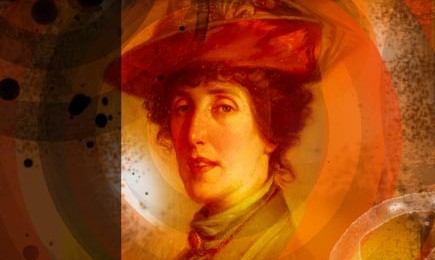
Revolutionary Women
Anna Garaseva (1902-1994) and Tatiana Garaseva (1901-after 1997)
Anna Garaseva and her older sister Tatiana were the daughters of a teacher who taught in a gymnasium (high school) in Ryazan. Tatiana was born in 1901 and Anna on the 7th of December, 1902.
In 1917, Tatiana was admitted to Moscow University, where she attended the lectures of the anarchist professor Alexei Borovoi. Tatiana joined the student anarchist club mostly made up of young women. She saw herself as an anarcho-syndicalist.
With the death of Kropotkin, his family and associates demanded that the Bolshevik government release imprisoned anarchists. Among these were Aron Baron, Topilin (himself from Ryazan, subsequently shot in 1921 for arranging a prison escape) and other anarchists, Left SRS and Makhnovists. The university teachers Borovoi and Karelin asked the leader of the Cheka, Dzerzhinsky, to release the prisoners but he refused. Borovoi then went to Lunacharsky, who prevailed upon Lenin to release six of the prisoners on parole, the rest remaining in prison.
At the funeral of Kropotkin there was a large turnout from the universities and Tatiana was one of those who carried a wreath from the Nabat confederation (even though as an anarcho-syndicalist she disagreed with their strategies) to lay on his coffin. She returned to Ryazan, where her sister still lived, after mass arrests of Anarchists and Left SRS and the suppression of the Kronstadt rebellion. Anna entered the Ryazan Pedagogical Institute, and joined the anarcho-syndicalist group there.
The two sisters then moved to Petrograd where they worked as nurses. They continued to participate in the anarcho-syndicalist movement. Tatiana kept in contact with exiled revolutionaries in Finland and rented a room in a house which happened to be opposite the windows of Grigori Zinoviev. She was arrested there on the 22nd of May, 1925. Anna, who had returned to Ryazan, was arrested the following year and a picture of Topilin along with their real name was found at her apartment. The two sisters were reunited in the Lubyanka prison.
They were accused of belonging to a terrorist anarchist organisation and of plotting to kill Zinoviev. At this time the interrogation of political prisoners did not involve beatings or torture. The sisters were sentenced to three years in the political-isolator prison followed by three years of internal exile. They served their time at the prison of Verkhneuralsk, where they met and became friends with many other political prisoners, joining them in collective protests and hunger strikes. Among these were the Right SR Katarina Olitskaya, the anarchist Vsevolzhsky, who was the nephew of the Red Army marshal Tukhachevsky and the anarchist Kira Arkadevna Sturmer, who was the niece of a minister of the Tsar. In Sverdlovsk they met Berta Brodova, wife of Yuri Podbelsky, an SR involved in the Antonov uprising in Tambov (his brother Vadim was Commissar of Post and Telegraphs in the Communist government).
In 1928, Tatiana contracted tuberculosis and was sent to Chikment. She filed a petition for a transfer home to Ryazan. The authorities agreed to this if she ended her political activities. She signed a statement to this effect to this whilst maintaining her beliefs. Tatiana returned to Ryazan in 1929, joined there soon by a recently released Anna.
In exile, Tatiana married Nikolai Semenovich Doskalov, a Belgian-born ex-Bolshevik who in the mid 1920s had changed his politics to anarcho-syndicalism. Together with her husband she moved to Maikop, where in 1935 she was arrested. After the first spell in prison she returned to Moscow and began working in the Lenin Library. The director of the Library was Nevsky, a former People’s Commissar of Labour. According to Tatiana he was the only decent Communist they ever met. He was not afraid to argue with Stalin, and he employed people expelled from the Communist Party after the wave of purges. He hired Tatiana and the old SR Kolosova. Nevsky was arrested in 1935 and shot in 1937. After his arrest, Tatiana and her husband fled to Maikop, but the secret police caught up with them. Nikolai was beaten to death during interrogation, and Tatiana received five years at the Kolyma camp.
There were many Communists at Kolyma, including Trotskyist oppositionists, but they all refused to have anything to do with anarchists who they regarded as enemies of the revolution. Tatiana met Katya Olitskaya again at Kolyma.
Tatiana with her tuberculosis would not have survived long at the dread prison camp of Kolyma if she had not started work at the camp hospital after one of her feet was amputated as a result of frostbite whilst working in the forest. Tatiana returned to Ryazan before the war. During the war, the sisters worked in a military hospital, and in 1949 Tatiana was again sent to Kolyma, where she remained until 1954.
The two sisters were rehabilitated in 1958. From 1962 onwards Anna made contact with the writer Solzhenitsyn who was compiling his huge book on the Gulag archipelago. She acted as his “illegal secretary”, helping compile information on the camps, putting him in contact with others who had suffered in the camps and hiding documents for him. The sisters felt that there was not enough information in the book on Kolyma which was “our Auschwitz”.
In her last years Anna, disillusioned by the many years of suffering and repression, rejected her anarcho-syndicalist beliefs and began to see herself as an anarchist individualist. The anarchist journalist Igor Podshivalov conducted an interview with the sisters in 1994. They were living in Ryazan on small pensions. Six months later Anna died on the 11th of December, 1994. Tatiana died some time after 1997. In 1997, Anna’s memoirs of her activities in the anarchist underground were published.

Social Media